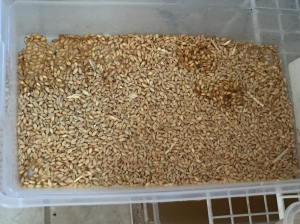Most poultry books tell your birds need lots of fresh greens, particularly geese and ducks. This isn’t a problem in the summer time. There’s lots of green grass, bugs, dandelions, you name it – it’s out there. Winter, however, is another story. You have to provide the greens, which can get expensive, and not all poultry like the same thing. Chickens love cabbage, and all your kitchen scraps. Ducks and geese turn their nose up at it. The ducks go nuts for peas, my geese won’t touch them. You could just forgo the greens, and stick to their feed, after all, that has all the nutrition they need. What it doesn’t have is, well, greens. The geese, ducks, and chickens all start to get ornery when they don’t have any. Not to mention, everything I read said geese aren’t too fond of their feed, and could go on hunger strike (they’ve never done that, but best to stave off the possibility). What to do?
After some research, I discovered fodder. What is fodder you ask? Simply put, fodder are grains that you have sprouted to feed your domestic animals. People will talk about sprouts and fodder interchangeably, but if you are curious about the difference it is the height of the greens you have grown. Sprouts are less than four inches in height, and fodder is greater than four inches.
There are quite a few benefits for fodder or sprouting:
- Your birds have year-around access to fresh greens.
- It is fairly inexpensive if done on a small scale. I use Scratch and Peck whole, organic wheat, or mixed grains. You can also use barley, or oats. These grains sprout easily because they haven’t been treated with anything to keep them from sprouting.
- The sprouts are more easily digested by the bird, and have more nutrition and fiber than a whole grain.
- It is pretty easy to do.
Want to try it, but not sure how to get started? As long as you are not doing a large scale operation, you don’t need much. I went and got clear shoebox size plastic bins, and some stackable metal shoe racks. I drilled holes for the water to drain through around the bottom of the bins, and in the middle. There are bins on the bottom that catch the excess water as it drips through each one. Then, I got my grain. I pour enough grain to cover the bottom, and then I water every other level. The water goes through each one, and waters the one underneath it. After that, I wait for the grain to sprout. You don’t have to use a green light, but I do. The greens seem to sprout more quickly than when I didn’t have one. It takes about 3 to 4 days, and then it’s ready to give to the birds. The root mat will hold it all together as a brick, so it’s pretty easy to empty.
When you get started, keep in mind you’ll need to rinse the container after you empty it. If you don’t, the drain holes can get clogged, and then the water doesn’t go through properly, and mold can develop. Make sure you check the drain holes after each use, and clean them out.
The geese and chickens love the fodder. I bring it out, and they start eating it right away. Not too much is left behind, so there is minimal waste.
Try it out! It’s simple to get started, and is inexpensive. With our long winter days, your birds will appreciate the fresh greens and be happier for it.




Sounds like a practical idea, and you can scale it for your number of birds.
LikeLiked by 1 person
That’s one of the things I really like. You can be elaborate in your set up, or very simple. And, the fodder is pretty forgiving if you forget to water one day (unlike some house plants).
LikeLiked by 1 person
Thanks for sharing! We’ll be releasing a brand new system for sprouting that’s specifically designed for poultry. Check it out: http://www.fodderworks.net/pages/sprouting-system-for-poultry
LikeLiked by 1 person